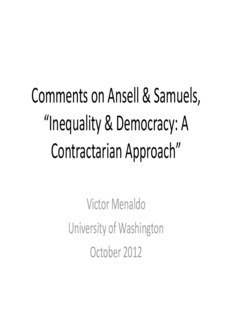
Comments on Ansell & Samuels, “Inequality & Democracy: A Contractarian Approach” PDF
Preview Comments on Ansell & Samuels, “Inequality & Democracy: A Contractarian Approach”
Comments on Ansell & Samuels, “Inequality & Democracy: A Contractarian Approach” Victor Menaldo University of Washington October 2012 There’s a lot to like here • Robustness to Dependent Variable (Regime Type) • Robustness to Independent Variable (Income Inequality) • Robustness to Econometric Strategy (Dynamic Probit; Static & Dynamic OLS; Pooled and FE OLS; Instrumental Variables OLS) • Concern over causal inference: FE models and IV Models Your OLS FE Models = Too Simple • Partial adjustment models may impose invalid restrictions (DeBoef & Keele 2008). • Lagged D.V. close to unity in many models and we know Polity tends to not revert back to its mean (Haber & Menaldo 2011). • We also know inequality is slow moving. Prescriptions • Diagnose time‐series properties variables 1) Panel Unit Root Tests for each series and 2) Panel Co‐integration Tests for Polity & Gini • Run more sophisticated dynamic models 1) Finitely distributed Lag Models (FDL) 2) Autoregressive Distributed Lag Models (ADL) Your IV Models = I’m Skeptical • Instruments may not satisfy exclusion restriction 1) Inequality = high serial correlation; lags not ideal 2) Regional inequality may operate via diffusion 3) Bigger betas in IV second‐stage may signal exclusion restriction not satisfied • Instruments may be weak We have no way of knowing, you don’t diagnose Perhaps Regional Inequality correlated with these omitted variables? GINI Coercion Growth Oil P.C. #Past Trans. Inflation GINI 1.0000 Coercion -0.1363*** 1.0000 Growth -0.0946*** 0.0894*** 1.0000 Oil P.C. -0.0193 0.1922*** 0.0193 1.0000 #Past Trans. -0.1323*** 0.1348*** 0.0085 -0.0370 1.0000 Inflation -0.1448*** 0.1801*** -0.1113*** 0.1861*** 0.1010*** 1.0000 “Coercive Capacity and the Prospects for Democratization” Comparative Politics 2012 (w/Mike Albertus) Table 3. Determinants of Democratic Transition after controlling for Income Inequality (1950 to 2002) Dependent variable is Binary Democracy measured as REGIME (Markov Transition Model) Robust z statistics clustered by country in brackets Measure of Income Inequality Boix Gini Boix Gini SIDD Gini SIDD Gini Capital Shares Capital Shares Capital Shares (1) (2) (3) (4) (5) (6) (7) Income Inequality -0.021 0.848 0.009 0.074 -0.019 -0.223 -0.238 [0.54] [2.02]** [0.48] [0.40] [1.10] [2.10]** [2.63]*** Income Inequality Quadratic -0.008 -0.001 0.159 0.169 [2.00]** [0.35] [1.91]* [2.37]** Turning Point for Income Inequality 50.64 GINI 55.34 GINI 69.99% C.S. 70.48% C.S. 95% Confidence Intervals [45.13, 56.16] [6.59, 104.08] [59.70, 80.27] [61.39, 79.57] log(Military Size) -1.098 -1.257 -0.616 -0.602 -0.667 -0.583 -0.468 [2.69]*** [3.17]*** [2.42]** [2.44]** [2.03]** [1.57] [1.95]** log(Per Capita Income) 0.287 0.358 -0.041 -0.029 0.09 -0.016 -0.28 [0.52] [0.58] [0.14] [0.10] [0.23] [0.04] [0.96] Growth Rate -0.09 -0.091 -0.045 -0.045 -0.051 -0.046 -0.045 [1.79]* [1.87]* [0.92] [0.92] [0.68] [0.58] [0.94] log(Total Oil Income) -0.361 -0.436 -0.206 -0.208 -0.235 -0.273 -0.194 [3.03]*** [3.43]*** [2.74]*** [2.74]*** [2.65]*** [2.62]*** [2.07]** Number of Previous Transitions 0.194 0.1 0.325 0.324 0.046 -0.044 [0.80] [0.41] [2.24]** [2.26]** [0.27] [0.28] Inflation 2.093 2.026 4.926 5.063 2.096 2.112 [1.32] [1.20] [3.10]*** [2.92]*** [1.09] [1.14] Military Regime in power 1.829 1.966 2.038 2.037 1.977 1.859 1.772 [2.57]** [2.43]** [5.72]*** [5.69]*** [4.41]*** [4.19]*** [4.53]*** Region Dummies YES YES YES YES YES YES YES Year Dummies YES YES YES YES YES YES YES Observations 594 594 1342 1342 1115 1115 1626 * significant at 10%; ** significant at 5%; *** significant at 1% All independent variables lagged by 1 period. Year dummies estimated but not shown; region dummies estimated but not shown. Prescriptions • For Exclusion Restriction concerns 1) Include more covariates in IV model 2) Provide more than 1 instrument in First‐Stage & run Sargan Test of over‐identifying restrictions • For Weak Instrument concern 1) Show us first‐stage models! 2) Conduct first‐stage F‐test/weak instrument tests Some Instrument Ideas • Exploit fact that technology increases inequality because of higher returns to human capital and does not diffuse uniformly (endogenous growth theory) • Exploit fact that capital market liberalization increases inequality • Exploit fact that trade liberalization sometimes increases inequality Table 6.3 Conditional Logit FE Models? • How are these conditional models if they include dummy variables? That’s unconditional FE regression. • If so, estimation inconsistent because of incidental parameters problem (Neyman & Scott 1948).
Description: